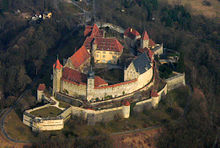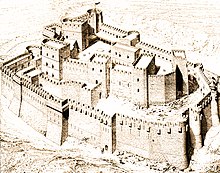Zwinger (architecture)

A kennel is an open area between two defensive walls that is used for defense. Kennels were built in the Middle Ages and early modern times to reinforce castles and city walls .
Zwinger of a castle
The kennel of a castle is in front of the curtain wall and is closed on the field side by a second, lower wall, which is called the Zwingermauer . If attackers managed to get past the kennel wall, they would be encircled in the kennel and an easy target for the defenders on the main wall. This made further penetration much more difficult.
In Central Europe, most of the kennels were built in front of older castle walls as reinforcement.
Kennel in front of a city gate
The kennel in front of a city gate is a fortified space between the main gate and the front gate of a medieval city gate. The city gates were often designed in the form of a gate tower , with a second (so-called double gate system ), sometimes also a third gate in front of the main gate . In front of the city walls, in the area of the city gates, a second wall section, in which the front gate was located, was usually built. An enemy who had captured the front gate and advanced into the kennel found little opportunity to develop in the cramped space. On the other hand, the retreating defenders could easily fight the enemy who had entered the kennel.
The barbican is based on a similar concept as the gate kennel , but is separated from the main wall by another moat.
In the Hussite period (around 1420/30) impressive examples were created, which were mostly planned to protect against early firearms .
The uncovered space was often used to keep animals or as a garden in peaceful times . In many cases, barns , stables and warehouses were built on when their military function became unnecessary.
The Dresden Zwinger has inherited its name from the former kennel in front of the Kronentor on the outer fortress wall. However, it was not planned as a fortification, but as the forecourt of a new castle.
development
The development of the kennel has not yet been adequately researched. As early as the fifth century AD, the Byzantine land wall of Constantinople was presented with a fully developed kennel.
The depth of the ramparts can also be demonstrated in the early medieval fortifications. Protective castles from the Hungarian period in particular were secured with berms and ramparts in front of them to protect them from cavalry attacks by the Magyars . However, these are not kennels in the true sense of the word; an intermediate ditch often separates the fortification lines. Such a ditch is sometimes also found in late medieval kennels.
Occasionally the narrow fortifications of the Habsburg (Aargau) or the Alt-Bolanden Castle (Rhineland-Palatinate) are viewed as early kennels of the late 10th and early 11th centuries. However, these fastening concepts remained without direct successors.
In Central Europe, kennels were only added to the ring walls of individual fortifications again in the first half of the 13th century. Towards the end of this century the suitability for defense was increased in this way much more frequently ( Burg Gnandstein , Saxony; Burg Landsberg and Burg Hoh-Andlau , both Alsace). In the south of France, the kennel of the city fortifications of Carcassonne has also been vividly preserved from this era - heavily restored . At the beginning the walls of the kennel were very close to the main wall.
In the 14th century, the development of the first firearms forced further development of the Zwinger. Countless examples emerged, especially in the 15th and 16th centuries. In Franconia , even the fortifications of a late medieval city have largely been preserved. In Nuremberg , the older ring wall was given a lower kennel. In the early 15th century Munich receives a completely new city fortification made of a double wall ring. The connection of the watchtowers of the inner (= higher) and outer (= lower) wall with partition walls resulted in a series of numerous kennels that soon completely framed the place.
The first enclosure walls of the High Middle Ages were mostly not yet secured by towers. The artillery fortifications of the late Middle Ages, on the other hand, were reinforced by numerous flanking and sometimes gun towers.
The kennels of a small group of castles in the Franconian Haßbergen date from the Hussite period . As elsewhere, the sovereigns reacted to the acute threat from the rebels from nearby Bohemia . The kennels of the castles Altenstein , Rauheneck and Schmachtenberg have been well preserved . At the Rauheneck Castle , two gunmen used to strengthen the defense force. Such bay windows and fighting houses can also be found in other kennels.
The Hussite-era extensions of numerous castle complexes in the endangered areas often go back to innovations that were developed by the Hussites themselves. The town fortifications of the South Bohemian Hussite town of Tábor should be mentioned here in particular . The kennel in front of the main wall has been partially preserved up to the present day.
As a rule, the kennel walls were significantly lower and weaker than the actual curtain walls. Often only a parapet wall rose above the leveled kennel area. Occasionally a covered or open battlement was put on ( Trausnitz Castle , Landshut ). There are also evidence of underground battlements with openings for handguns ( high-rise castle near Nördlingen ).
Kennel walls can completely surround a defense system or only protect a particularly endangered section. Often there is a trench in front of it, the kennel wall is also the lining wall of the trench. In hillside castles, the kennel wall was often built up very high as a retaining wall and thus also serves to statically secure the entire system.
Small, hidden outposts ( posternes ) often made it possible to actively fight an enemy who had penetrated the trench area. The actual kennel area was also often accessible through such hatches.
Early high medieval kennels in the Holy Land
The Krak des Chevaliers of the Order of St. John is generally regarded as the epitome of a crusader castle . Shortly after 1170, a first narrow kennel was built around the inner castle. This kennel complex, which can be dated surprisingly early, was replaced in the middle of the 13th century by the preserved external reinforcement. This kennel is also one of the oldest examples of this type. A building inscription tells of a “barbacane” (this certainly describes the kennel) that the castle administrator Nicolas Lorgne had built. From this source, the second kennel of Krak (Crak) can be dated to around 1250.
The Krak kennel was expanded until around 1270. Despite this reinforcement, the Muslims under their Sultan Baibars I managed to take the fortress in 1271 after only four weeks of siege.
Other large crusader castles are also surrounded by extensive kennels. The outer wall of the castle of Tartus (Syria) could have been built around the same time as the Krak Zwinger, in the middle of the 13th century. Shortly after 1168, the Johanniter began the renovation of Belvoir Castle in what is now Israel. The outer fortification with its angular towers looks like "a Zwinger extended to a building" (U. Großmann).
Double curtain walls in 13th century Wales
The Welsh castles Harlech Castle and Beaumaris Castle (begun in 1295 but unfinished) have double defensive walls, with the outer wall concentrically enclosing the inner one at a small distance. The outer fortification in Beaumaris with its round wall towers is particularly complex, comparable to that of the Krak des Chevaliers.
Examples of preserved medieval kennels
City fortifications:
- On the mountain
- Aschersleben
- Carcassonne
- Delitzsch
- Dinkelsbühl
- Goerlitz
- Ingelheim am Rhein
- Jueterbog
- Neubrandenburg
- Nordlingen
- Nuremberg
- Templin
- Wolframs-Eschenbach
Castles:
- Altenstein Castle (Hassberge)
- Burghausen Castle (Burghausen / Salzach, Upper Bavaria)
- Giechburg (Upper Franconia)
- Guttenberg Castle on Neckar (Neckar-Odenwald District)
- Hohenurach Castle (Swabian Alb)
- Hornberg Castle am Neckar (Neckar-Odenwald district)
- Löwenstein Castle (Swabian-Franconian Forest Mountains)
- Minneburg (Odenwald)
- Nürburg Castle (Eifel)
- Veste Otzberg ( Otzberg )
- Rauheneck Castle (Ebern)
See also
literature
- German Castle Association (Hrsg.): Castles in Central Europe. A manual. Volume 1: Designs and Development . Konrad Theiss, Stuttgart 1999, ISBN 3-8062-1355-0 , pp. 234-235.
- G. Ulrich Großmann : The world of castles. History, architecture, culture. CH Beck, Munich 2013, ISBN 978-3-406-64510-5 , pp. 60-62.
- Michael Losse : Little Castle Studies. Regionalia, Euskirchen 2011, ISBN 978-3-939722-39-7 , pp. 72, 74.
- Michael Losse: kennel, enclosure. In: Horst Wolfgang Böhme , Reinhard Friedrich, Barbara Schock-Werner (Hrsg.): Dictionary of castles, palaces and fortresses. Reclam, Stuttgart 2004, ISBN 3-15-010547-1 , p. 273, doi: 10.11588 / arthistoricum.535 .
- German Castle Association (Ed.): Zwinger and Vorbefestigungen. Verlag Beier & Beran, Langenweißbach 2007, ISBN 978-3-937517-68-1 .
Individual evidence
- ^ Piper, Otto: Burgenkunde. Construction and history of castles. Würzburg 1995, p. 684.





